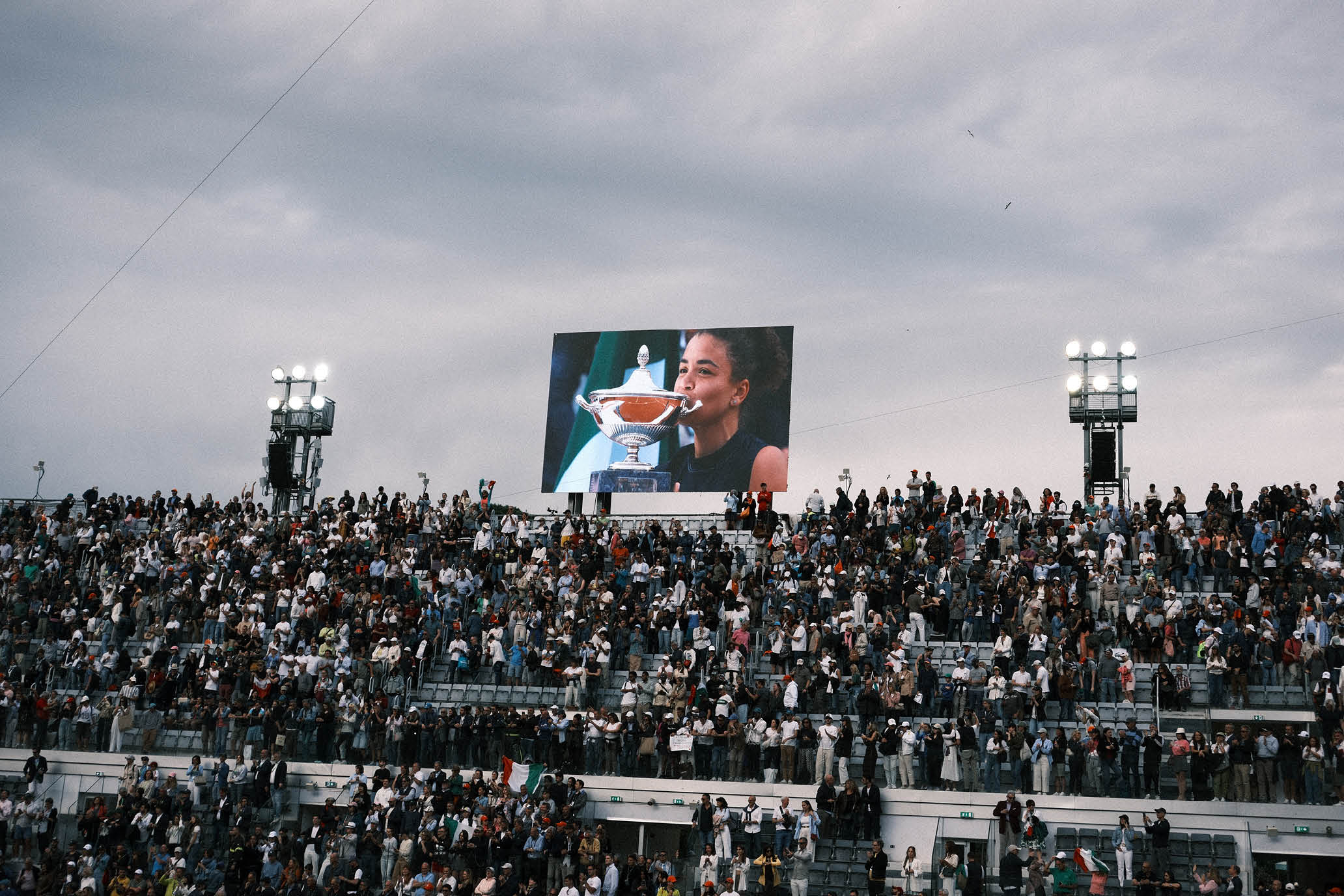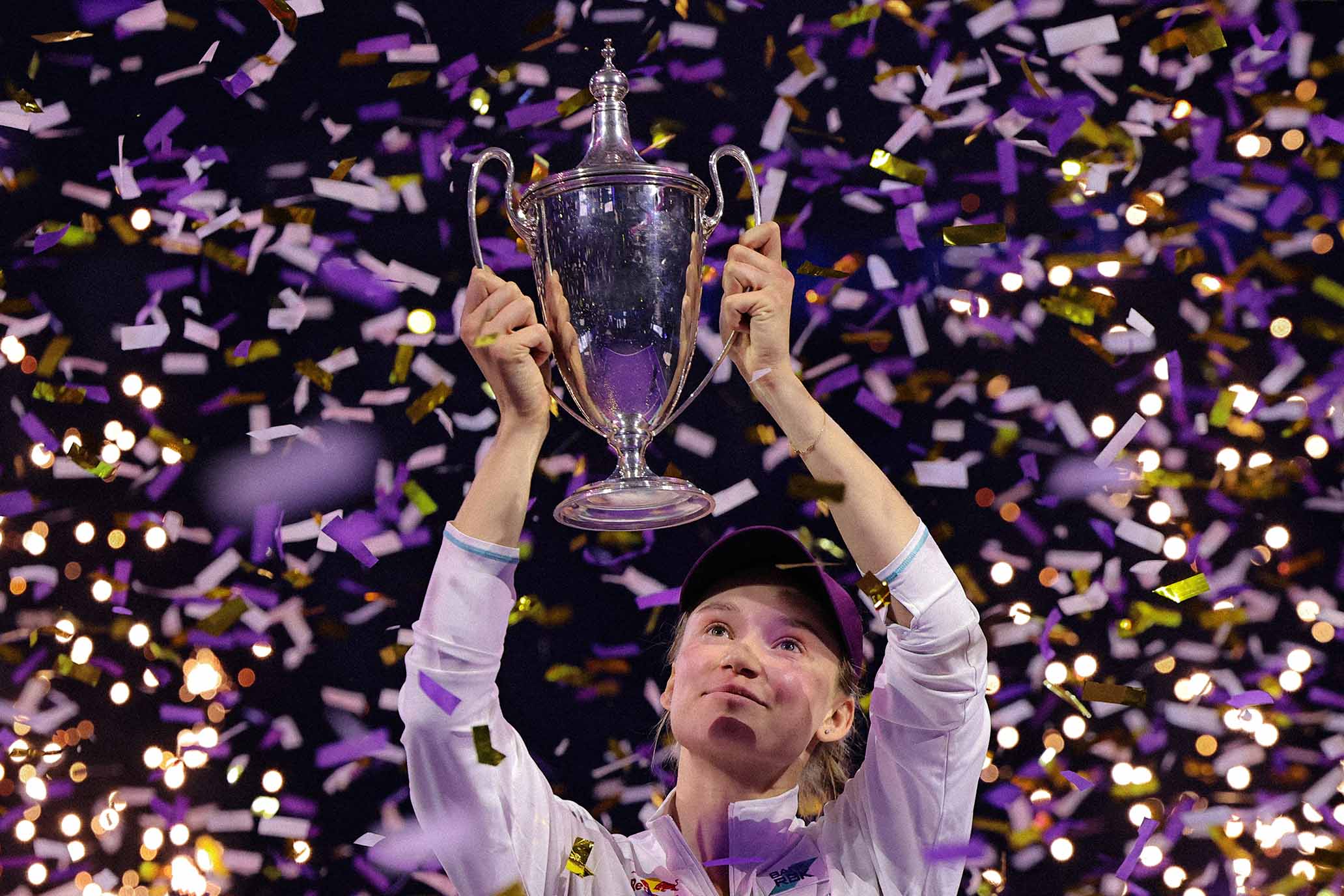The Arms Race Continues
The Arms Race Continues
Carlos Alcaraz and Jannik Sinner are adding to their arsenals.
Carlos Alcaraz and Jannik Sinner are adding to their arsenals.
By Owen LewisNovember 20, 2025

Sincaraz during their clash at the ATP Tour Finals. // Getty

Sincaraz during their clash at the ATP Tour Finals. // Getty
I knew the tennis that defined the legendary Big Four era was dead when Jannik Sinner saved set point against Carlos Alcaraz with a 117 mph second serve. It was at 5–6 in the first set of the championship match at the ATP Finals. Sinner had just watched Alcaraz thrash a forehand winner past him, feather a drop shot beyond him, and flail an outrageous reflex volley right in front of his eyes. Staring down set point after that devastating trio of hot shots, Sinner missed his first serve. Rather than roll in the second delivery, Sinner pasted it into Alcaraz’s backhand and was rewarded with a free point. Sinner went on to win the match 7–6 (4), 7–5, owing significantly to that moment of bravery in crisis.
Afterward, Sinner offered an explanation for his audacity: “I would rather lose that point than have him win it.”
Talk about seizing your fate. Sinner wanted to reduce a game played by two people to a game against himself, even if it meant burial via his own shovel. It’s also the greatest possible compliment to Alcaraz’s skill set: He is so dangerous that under ideal circumstances, he cannot be permitted to hit a single shot with his feet set. But more than anything else, Sinner’s ethos represented a complete departure of the mindset that governed the Big Four era. In his autobiography Rafa, Rafael Nadal assured his uncle Toni during a dire passage of the 2008 Wimbledon final that while Roger Federer might win the match, Nadal would not lose it. Before the match, he notes that he shouldn’t jump at a 70 percent chance to hit a winner when an 85 percent chance might present itself a few shots later in the rally. Alcaraz and Sinner would have laughed.
Nadal hit his share of awesome winners on big points. But how he really made his money (before becoming Saudi Arabia’s tennis ambassador) was by refusing to miss on a big point. If his opponent baited him into hitting the best shot of the day, Rafa was happy to thwack it. But more often, he’d simply hold the line until his opponent inevitably faltered, not pressing into the dangerous territory of hot shots unless someone forced him to. Even Novak Djokovic, the lone man who can claim to be more clutch than Nadal, could be guilty of passivity in his prime every once in a while. Djokovic shrunk the court down to its outer reaches in a phenomenally successful wager that his opponent couldn’t strike the outside of the lines consistently over the course of three hours. Those who could, though, like Dominic Thiem in a couple deciding-set tiebreaks, or Stan Wawrinka in a couple major finals, occasionally became the defining force in their matches. If you happened to get hot, Djokovic sometimes gave you the opportunity to beat him. Roger Federer was more aggressive than both Djokovic and Nadal, but his accuracy waned when his matches against them tightened and they elicited his errors over and over. And Andy Murray could be infuriatingly passive at times, more so than any of the others.
In his late career, Djokovic seemed to decide that he’d rather lose a point by his own hand than let his opponent bang a return winner, or run him around the court. Thus the huge second serve began to feature in his game, the bailout drop shot, the fuck-it running forehand winner. Djokovic missed these shots at times, but in trying them so often, he denied his opponents momentum, rhythm, or even the satisfaction of agency in their own success. Even when he walked to the net defeated, there was often a sense that he’d chosen to be there.
The Sincaraz Empire (2024–????) has preserved this raw aggression and left most of the other Big Four relics behind. There is no room for passivity, for trying to make the opponent miss, for hesitation. They debuted this futuristic brand a few years ago, but it’s since evolved further and solidified into a kind of law. Sunday’s Alcaraz–Sinner final may have been the most straightforwardly offensive matchup between top players I’ve ever seen. Though both are adept defenders, they often let loose a counterpunching winner before they’d even had the chance to spend much time on the run—as if scrambling for more than a second at a time was a death sentence. Long rallies felt like a happy accident of their sublime foot speed rather than a conscious decision to trade before striking. Sinner pointed to his ear triumphantly after winning the lengthiest exchange in the second set, and it struck me that in a vintage Djokovic–Nadal match, the 24-shot collaboration would have essentially qualified as an average point. Alcaraz’s love for drop shots is well established, but the rallies operated at such a pace that he simply didn’t have time or space to hit more than one or two good ones. The matches are now largely a hitting contest: The player who hits their biggest forehand onto the tiniest target wins.
“Aces are like rain. You accept them and move on,” Nadal wrote in Rafa. Try telling that to Alcaraz, who reacts to aces by frustratedly emphasizing their tenuous path between the lines with thumb and forefinger, and stared in disbelief at the radar gun after many of Sinner’s best serves on Sunday. Carlos returned the favor, though. Early in the second set, he hit consecutive forehand winners down the line—one, two, three—each blast harder than the last. Both players can hit any spot on the court, from any spot on the court, and the opponent having that power is simply too dangerous. Every point must instead be ruthlessly ended as soon as possible.
That echo of pure proaction, more than anything else, was my lingering memory from Sincaraz XVI. (Despite a perfectly even split in the points spread, 1,651 apiece, Alcaraz still leads the head-to-head 10–6; had Sinner converted match points in their matches at the 2022 US Open and Roland-Garros final this year, we could be at 8–8.) It’s not always the most intellectually stimulating tennis to watch—at times I catch myself craving angled shots that tease the sidelines of the court alongside flat missiles through its back, or the myriad tactics at play in a lung-busting Djokovic–Nadal 54-shot rally. But it’s certainly gripping even at its worst, and incandescent at its best.
It’s hard to draw too many conclusions from the match itself. Jannik came up with a pair of gorgeous lobs in the first-set tiebreak, impressive not only for the execution but that they were hit at all—touch shots are not usually Sinner’s go-to even in the least consequential points, much less at crunch time against the one player on tour who can rattle his equilibrium. Those shots were indicative of both the increased unpredictability Sinner promised after the US Open and an ability to bounce back without fear from oh-so-many heartbreaks against Alcaraz. He did do it against a somewhat compromised version, though: Alcaraz pulled up with a hamstring edema about 45 minutes in, after which his typically violent movement around the court went dormant. He maxed out his aggression instead, resulting in a few unanswerable winners but plenty more questionable approach shots and volleys that Sinner duly punished. It seemed to me that Alcaraz’s condition incentivized him to rush into suicidal net rushes at times, and I wonder if he’ll allow Sinner to be in position to hit those lobs next time around. Alcaraz pulled out of the Davis Cup rather than risk a hamstring tear, which furthers the impression that Sinner ending the match in two sets was probably the best thing for both players.
Where this hyperaggressive brand of tennis goes from here, I have no idea. Enjoy it while you can—their last two matches have featured incredibly dominant first-serve performances, cutting down on the number of breaks of serve and baseline exchanges in general. If their serves continue to improve at this frightening rate, there’s one clear way to foster more of the valuable, resonant rallies in their rivalry: make them start every point with a second serve.



